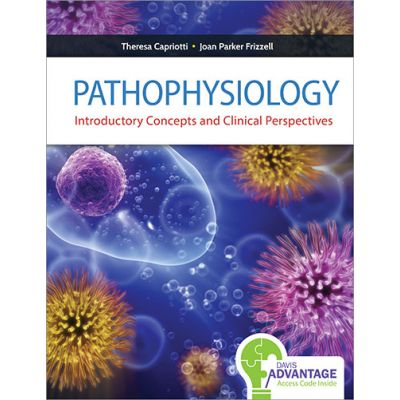Pathophysiology: Introductory Concepts and Clinical Perspectives

DESCRIPTION
Davis Advantage Pathophysiology combines an innovative text with an online program that makes this challenging, but must-know content easier to master. Pathophysiology and the Personalized Learning Plan work together to provide everything you need to succeed.
TEXT
Pathophysiology
Introductory Concepts and Clinical Perspectives
Real-world perspectives bridge the gap between the science of disease and clinical patient care. You’ll clearly see “how” to interpret assessment findings and “why” to choose interventions.
Chapters organized by body systems help you understand the relationships between the underlying pathology and the patient assessment data, laboratory findings, and diagnostic testing results.
Davis Advantage for Pathophysiology
A wealth of interactive case studies, quizzes, videos, animations and dynamic exercises, plus an integrated e-book version of the text, offer multiple paths to learning success. This immersive, multimedia experience tracks you progress until you have mastered the concepts and are ready to apply them in class, clinical, and practice.
A 3-year access code inside new, printed texts unlocks Davis Advantage for Pathophysiology for you.
- Full-color illustrations compare normal anatomy and physiology to pathophysiology.
- X-rays, CT scans, MRIs, ultrasound pictures, nuclear studies, ECGs, pathology samples, anatomical diagrams, tables, figures, and algorithms illustrate key concepts.
- Unique “Making the Connections” boxes link symptom, assessment finding, pathophysiologic mechanism, diagnostic test result, treatment, and nursing interventions.
- “Clinical Concept” boxes throughout explain how key concepts apply to clinical practice.
- Concise summaries at the end of each chapter cover the most important concepts of disease processes.
- Flowcharts make it easy to follow pathophysiologic processes.
- A special emphasis on the clinical applicability of pathophysiology develops the critical-thinking skills essential to selecting appropriate interventions.
- Content on pathophysiologic mechanisms on a molecular level and genetic concepts in relevant disorders helps you to understand common disease processes, diagnostic tests, and treatments based on altering cell mechanisms.
Davis Advantage for Pathophysiology
- Create a Personalized Learning Plan by beginning with a pre-test for each module that assesses your strengths and weaknesses.
- Follow your personalized learning plan to ensure you master the content.
- Experience immersive, interactive, multi-media learning with a wealth of quizzes, animations, and dynamic exercises offer multiple paths to learning success.
- Track your progress in every step of the way in your “Gradebook; you’ll know exactly how you’re doing and where you need to focus your studies.
1. The Cell in Health and Illness
2. Cellular Injury, Adaptations, and Maladaptive Changes
3. Genetic Basis of Disease
II. Integrated Body Processes
4. Stress, Exercise, and Immobility
5. Obesity and Nutritional Imbalances
6. Pain
III. Fluid, Electrolyte, and Acid-Base Homeostasis
7. Fluid and Electrolyte Imbalances
8. Acid-Base Imbalances
IV. Infection and Inflammation
9. Inflammation and Dysfunctional Wound Healing
10. Infectious Diseases
11. Disorders of the Immune System
V. Hematologic Disorders
12. Disorders of White Blood Cells
13. Disorders of Red Blood Cells
14. Disorders of Platelets, Hemostasis, and Coagulation
VI. Disorders of Cardiovascular Function
15. Arterial Disorders
16. Ischemic Heart Disease and Conduction Disorders
17. Heart Failure
18. Valvular Heart Disease
19. Disorders of the Venous System
VII. Pulmonary Disorders
20. Respiratory Inflammation and Infection
21. Restrictive and Obstructive Pulmonary Disorders
VIII. Renal and Urological Disorders
22. Renal Disorders
23. Urological Disorders
IX. Hormonal and Reproductive Disorders
24. Endocrine Disorders
25. Diabetes Mellitus and the Metabolic Syndrome
26. Disorders of the Female Reproductive System
27. Disorders of the Male Reproductive System
28. Sexually Transmitted Diseases
X. Gastrointestinal Disorders
29. Disorders of the Esophagus, Stomach, and Small Intestine
30. Common Disorders of the Large Intestine
31. Infection, Inflammation, and Cirrhosis of the Liver
32. Gallbladder, Pancreatic, and Bile Duct Dysfunction
XI. Neurological Disorders
33. Cerebrovascular Disorders
34. Chronic and Degenerative Neurological Disorders
35. Brain and Spinal Cord Injury
36. Psychobiology of Behavioral Disorders
XII. Musculoskeletal Disorders
37. Musculoskeletal Trauma
38. Degenerative Disorders of the Musculoskeletal System
39. Infection and Inflammatory Disorders of the Musculoskeletal System
XIII. Cancer
40. Cancer
XIV. Integumentary Disorders
41. Skin Disorders
42. Burns
XV. Sensory Disorders
43. Eye Disorders
44. Ear Disorders
XVI. Disease Across the Life Span
45. Chapter 45: Pediatric Disorders 1053
46. Chapter 46: Pathological Concepts of Aging 1091
47. Chapter 47: SIRS, Sepsis, Shock, MODS, and Death 1107
Book categories
-Special order
-Publishers
-Promo
-Callisto Publications
-New books
-- 294,00 lei
- 453,60 leiMRP: 504,00 lei
- 315,00 lei
Promotions
-- 453,60 leiMRP: 504,00 lei
- 441,00 leiMRP: 514,50 lei
- 567,00 leiMRP: 630,00 lei











OUR VISITORS OPINIONS